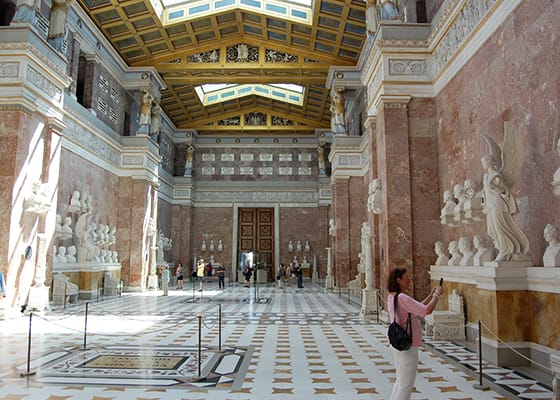REGENSBURG DAY 3: HISTORICAL TOURS
All information on our website is for a first impression of the journey you are planning. You will find detailed information in our travel guide “3 Days in“, which you can buy as soft cover book at your book store or directly in our BKB shop on this website. There you also can buy the travel guide as an ebook.
THE MINORITENKIRCHE
You will find many exciting things from the history of Regensburg and East Bavaria during a visit of the Historical Museum, which presents its exhibition in the beautiful ambience of the former Minorite monastery. A city model gives a wonderful overview of the time around 1700. Numerous archaeological discoveries of prehistory and early history as well as works of art, tombstones, coins and everyday objects from Roman Regensburg provide many insights into the early history of the city.


THE HISTORICAL …
There could hardly be a more impressive setting for an exhibition on medieval times than the rooms of the Franciscan monastery and its cloister. In addition to sculptures from the cathedral and the monastery itself, exhibits and well-crafted signs of how life took place in the Middle Ages, how the urban living culture looked, the importance the guilds had for economic life, how waste disposal functioned, what illness and death meant, and much more.
… MUSEUM
Altarpieces, plaques, carpets, sculptures and other works of art complement the collection on the first and second floors and span a great arc from the medieval age to historicism. Impressive are the paintings of the Danuble School, the artistic trend in Bavaria and northern Austria in the transition from Late Gothic to the Renaissance, characterised by a new feeling for nature and, for the first time, granting nature an independent rank in the paintings.

THE DANUBE AND & THE WALHALLA
ON THE BOAT …
From the mooring at the Historisches Wurstkuchl 41 the boat goes down the river about ten kilometres from the city. The first thing to notice is the large construction site on the right bank, where the Museum for Bavarian History is being built. A bit further on, the next view is a neo-Gothic showpiece: the Bavarian king Maximilian II had the royal villa built in the mid-19th century as a summer residence in the middle of a park. At that time he could still look over the largely undeveloped landscape up to Walhalla.


… INTO THE VALLEY OF THE DANUBE …
When the city beach passes by with its beach baskets and beach chairs in front of the old warehouse, you have reached the Bavarian port of Regensburg, which is the largest in Bavaria and a significant logistics location as measured by the shipping cargo handling. For an impression of how attractive a holiday on the Danube can be, look over to the district of Schwabelweis on the left bank, where a large flight of steps, a sunbathing lawn and a pebble beach are an inviting spot to relax. Through the charming Danube valley, you continue past Donaustauf, in whose princely garden the only surviving remnant of the Thurn und Taxis Palace is the wooden structure of the Chinese Tower.
… TO WALHALLA
From a distance you already get a glimpse of Walhalla with its majestic outdoor stairway. Framed by the outlying hills of the Bavarian Forest, it rises above the landscape on the 405-metrehigh Bräuberg in the shape of a Greek temple. This remarkable edifice was commissioned by King Ludwig I of Bavaria (reigned 1825-48), who conceived the idea of a building to forge the unity of the German people while he was still crown prince.


